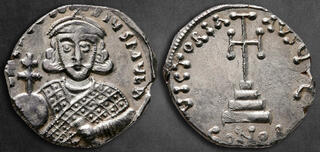| Savoca Numismatik GmbH & Co. KG > Online Auction 203 | Silver | Auction date: 24 March 2024 |
| Lot number: 625 Price realized: 3,600 EUR (Approx. 3,910 USD) Note: Prices do not include buyer's fees. | Show similar lots on CoinArchives Find similar lots in upcoming auctions on |
| Lot description: Anastasius II Artemius circa AD 713-715. Byzantine Hexagram AR mm, g D N ARTEMIYS ANASTAS]IYS MYL A, bust facing, wearing crown with cross on circlet and chlamys, holding akakia and globus cruciger / VICTORIA AVGY E/ CONOB, cross potent on four steps. Good Very Fine Sear 1468a Extremely Rare. Anastasius II Artemius, who reigned as Byzantine Emperor from 713 to 715 AD, is a relatively obscure figure in Byzantine history, overshadowed by the turmoil and transitions that marked the period. His short reign fell during a time of significant upheaval, characterized by internal conflicts and external threats, particularly from the Umayyad Caliphate. This context is essential for understanding the rarity of his coins. Anastasius II, originally named Artemius, ascended to the throne during a period of considerable instability. He came to power by overthrowing his predecessor, Philippikos Bardanes, amid discontent over religious policies and military failures. As emperor, Anastasius II attempted to restore stability to the Byzantine Empire by reforming its military and administration and by attempting to reconcile the religious divisions that had plagued the empire during previous reigns. However, despite these efforts, his reign was short-lived. After only two years, he was overthrown by Theodosius III, leading to another period of uncertainty. The rapid succession of emperors during this era, often through coups or revolts, meant that each ruler's tenure was precarious and usually brief. This political instability is a key reason for the rarity of coins from Anastasius II's reign. The production of coins in the Byzantine Empire was closely tied to the emperor's authority. Coins not only served economic functions but were also important for propaganda, depicting the emperor's image and reinforcing his legitimacy. When an emperor was overthrown, coins bearing his likeness would often be removed from circulation and melted down, to be replaced by those of his successor. This practice aimed to erase the deposed ruler's legitimacy and establish the new ruler's authority. Given the brevity of Anastasius II's reign and the subsequent efforts by his successors to legitimize their own rule, it is likely that many coins from his period were recalled and destroyed. Additionally, the chaotic nature of the era may have disrupted regular minting operations, resulting in fewer coins being produced in the first place. Furthermore, the lack of historical prominence and the relative obscurity of Anastasius II compared to other Byzantine emperors have contributed to a reduced interest in his reign and, consequently, less numismatic research into his coins. This lack of attention may have resulted in fewer discoveries and identifications of coins from his period. In summary, the rarity of Anastasius II's coins can be attributed to the brevity and instability of his reign, the subsequent eradication of his numismatic legacy by his successors, and the limited historical interest in his rule. These factors combined have made coins from his reign rare and valuable to collectors and historians alike Starting price: 2500 EUR |  |


